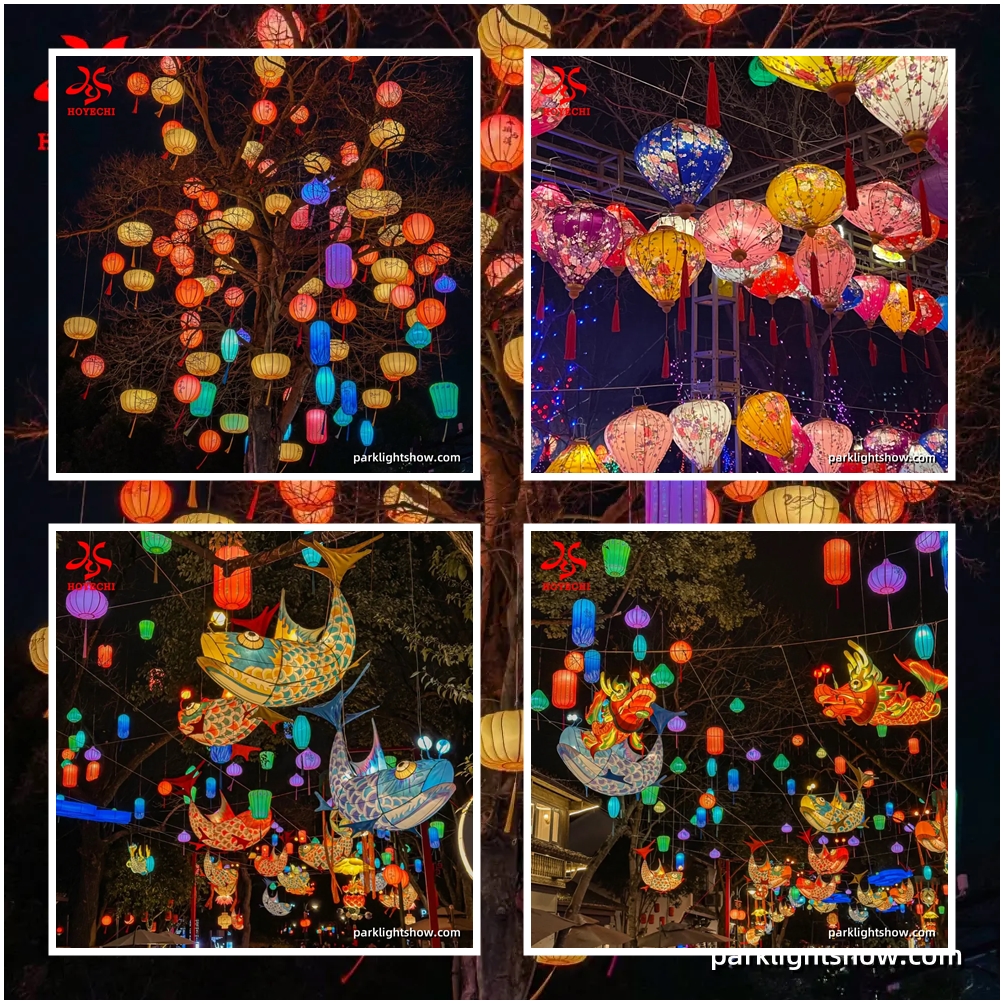Chinese Lanterns: Tradition Reimagined with Modern Craft
For centuries, Chinese lanterns have enchanted the world with their colors, shapes, and deep cultural meaning. While their symbolism and beauty remain unchanged, today’s lanterns are often built with modern materials and technology — making them more durable, weather-resistant, and visually dynamic than ever before.
In this guide, we’ll explore the history, styles, craftsmanship, and cultural role of Chinese lanterns, along with how they’ve evolved for contemporary festivals and global celebrations.
1. A Journey Through History
The story of Chinese lanterns dates back to the Han Dynasty (206 BCE – 220 CE), when they were used in Buddhist rituals to honor the Buddha. Over the centuries, their role expanded to public celebrations, cultural gatherings, and seasonal festivals.
The Lantern Festival, held on the 15th day of the first lunar month, remains the most famous event showcasing these luminous creations. Streets and parks are filled with glowing lanterns, marking the close of Lunar New Year with unity and joy.
2. Types of Chinese Lanterns
-
Palace Lanterns – Now often built with steel wire frames and PVC coverings printed with intricate designs, replicating the elegance of traditional silk and wood versions.
-
Gauze Lanterns – Still lightweight and colorful, but made from synthetic fabrics for better weather resistance.
-
Paper Lanterns – Popular for indoor events, often upgraded with LED lighting for safety.
-
Sky Lanterns– Mostly reserved for special events; modern designs use fire-retardant paper and eco-friendly materials.
-
Water Lanterns – Constructed from waterproof materials to float safely and illuminated with LEDs for a magical reflection on water.
3. The Modern Craft of Lantern-Making
While traditional lantern-making relied on bamboo frames, silk coverings, and candles, modern lanterns integrate metal engineering, advanced fabrics, and LED technology for longer life, brighter light, and greater versatility.
Frame Construction
Most modern lanterns use lightweight steel wire frames. These are rust-resistant, easy to mold into complex shapes, and strong enough for large-scale festival displays.
Covering the Frame
The outer layer is typically waterproof PVC or coated synthetic fabric. This not only allows for vivid, fade-resistant printing but also protects the lantern from rain, wind, and sun damage.
Lighting
Instead of open flames, lanterns now use energy-efficient LED lighting. LEDs are safer, consume less power, and can produce customizable effects — from warm glows to dynamic color changes synchronized with music.
Decoration & Innovation
Modern techniques allow for printed cultural motifs, photographic imagery, and 3D elements. Combined with programmable LEDs, lanterns can create immersive visual shows that blend heritage with modern artistry.
4. Symbolism and Cultural Importance
Despite their new materials, Chinese lanterns still carry the same rich meaning:
-
Hope and Good Fortune – Lighting a lantern is believed to invite blessings and ward off bad luck.
-
Unity – Round shapes symbolize family reunion and completeness.
-
Prosperity and Happiness – Red remains the dominant color for festive occasions, representing joy and success.
They remain an essential part of events like the Lantern Festival, Mid-Autumn Festival, and memorial rituals where water lanterns are floated to honor loved ones.
5. The Lantern Festival: Light, Tradition, and Celebration
Origins and Evolution
The festival began over 2,000 years ago as a Buddhist tradition and later merged with folk customs and Taoist beliefs. Today, it blends heritage with modern showmanship, often featuring massive LED-powered lantern installations.
Customs and Activities
-
Lantern Displays – From small hand-held lights to towering illuminated sculptures.
-
Lantern Riddles (Cai Deng Mi) – Still a favorite pastime, now often displayed on digital LED boards alongside physical lanterns.
-
Lion & Dragon Dances – Performed under vibrant LED-lit streets.
-
Eating Tangyuan – Sweet glutinous rice balls symbolizing togetherness.
-
Fireworks & Light Shows – Now often combined with laser projections and synchronized lighting systems.
6. Lanterns in the Modern World
-
Large-Scale LED Lantern Festivals – Cities like Zigong, Shanghai, and overseas cultural centers host massive displays with computer-controlled lighting.
-
Tourism & Cultural Branding – Lantern festivals are used to promote local culture and attract visitors year-round.
-
Event & Venue Decoration – Hotels, shopping malls, and restaurants use PVC & LED lanterns for both seasonal and permanent displays.
-
Eco-Friendly Designs – Solar-powered LEDs and biodegradable frames reduce environmental impact.
7. Experiencing Chinese Lanterns for Yourself
-
Visit a Major Lantern Festival – Zigong International Lantern Festival is a must-see.
-
Explore Lantern Museums – Learn the evolution from bamboo & silk to PVC & LED.
-
Join a Lantern-Making Workshop – Many workshops now teach modern wire-bending, PVC application, and LED installation.
-
Shop Lantern Markets – Purchase both decorative and functional LED lanterns for home or events.
8. Final Thoughts
Chinese lanterns have always been about light, beauty, and connection. While the craft has shifted from bamboo and candlelight to steel, PVC, and LED, the spirit of celebration and cultural pride remains unchanged.
Whether you see them at a bustling festival, in an art installation, or hanging in a restaurant courtyard, modern Chinese lanterns blend centuries-old tradition with the creativity and technology of today — shining brighter than ever in the global spotlight.
Post time: Aug-12-2025





